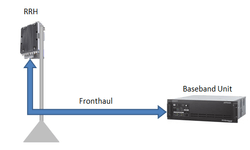O-RAN Fronthaul Spilt Option 7-2x
Open Fronthaul w.r.t. ORAN Alliance is referred as Lower Layer Split (LLS) having a goal to increase the flexibility and competition on the telecom market. Lower layer split refers to the split between the Radio Unit (RU) and the Distributed Unit (DU).
The O-RAN fronthaul interface can be transported on eCPRI. The eCPRI specification is designed to support 5G fronthaul requirements and offers several advantages e.g. eCPRI enables the efficient use of packet-based transport technologies and allows RAN payloads to be carried over Ethernet. The higher layers of the O-RU interface are implemented on top of eCPRI, with several different LLS Options (1 to 8) to split the functionality between the O-RU and the O-DU.
Split Option 7-2x is one of famous LLS split option adopted by by O-RAN fronthaul specifications. This functional splitting between Distributed Unit (O-DU) and Radio Unit (O-RU) divide the function of Phy Layer (Layer 1) named as High Phy resides in DU and Low Phy resides in RU. An overview of Split Option 7-2x is shown in below picture.

Downlink Bits Processing
In DL data flow, the user bit sequence received from the higher layer i.e. MAC layer undergoes encoding and scrambling, modulation and layer mapping, and precoding and Resource Element (RE) mapping resulting in an IQ sampling sequence of an OFDM signal in the frequency domain. This sequence is then performed IFFT processing to convert an OFDM signal in the time domain, and finally converted to an analog signal. In this flow, Beam Forming is performed before IFFT. The case of digital BF and after analog signal conversion in the case of analog BF.

In the DL, Split Option 7-2x implements functions up to RE mapping in the O-DU and supports both an O-RU that implements digital BF and later functions (Category A O-RU) and an O-RU that implements the above in combination with precoding (Category B O-RU). On the fronthaul an IQ sampling sequence of the OFDM signal in the frequency domain for each MIMO spatial stream or each MIMO layer will be transmitted. There is no need to transmit an IQ sampling sequence for a frequency resource transmitting no signals on the fronthaul in the DL.
Uplink Bits Processing
In Uplink flow, the OFDM signal in the time domain received at the O-RU and converted to a digital signal fed to FFT processing to get an IQ sample of the OFDM signal in the frequency domain. Then, after RE demapping, the process flow continues with equalizing processing, Inverse Discrete Fourier Transform (IDFT) processing, and channel estimation, and after demodulation, descrambling, and decoding, the process sends a user bit sequence to the MAC layer.

In this flow, Beam Forming (BF) is performed after FFT processing in the case of Digital Beam Forming and before digital signal conversion in the case of Analog Beam Forming. In the UL, Split Option 7-2x implements resource element mapping and higher functions in the O-DU and digital BF and lower functions in the O-RU. The fronthaul transmits an IQ sample sequence of the OFDM signal in the frequency domain for each MIMO spatial stream. There is no need to transmit an IQ sample sequence for a frequency resource transmitting no signals on the fronthaul.
Related Post:
- 5G NR gNB Logical Architecture and Its Functional Splits
- 5G NR gNB High Layer Split
- Open RAN (O-RAN) Reference Architecture
- What is eCPRI, how it contributes to 5G and Open RAN?



